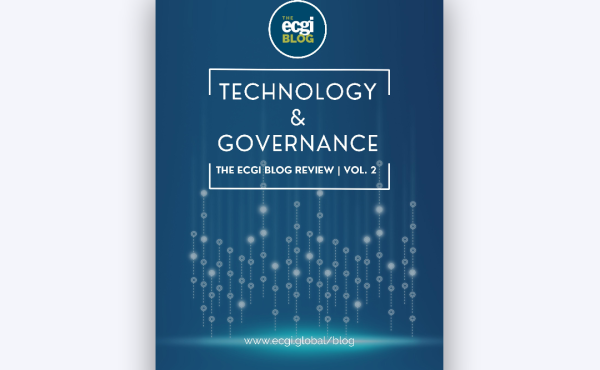
The ECGI blog is kindly supported by

Fintech and innovation in emerging markets: some common challenges and opportunities
Technology continually transforms the way that firms carry out their business. Financial firms have not been the exception. The rise of Fintech— which is the provision of financial services using new technologies—is a case in point on how innovation has spilled over to all stages of the commercial lifecycle. Tech has permeated how financial firms conduct their business, comply with regulations (Regtech), and even how they interact with regulators and supervisors (dubbed ‘Suptech’).
Despite its promise, digital transformation poses multidimensional governance challenges for financial services providers
Fintech has the potential to make people’s lives better—especially those who have been financially excluded or underserved by conventional services providers. Fintech’s promise could impact access to credit, savings and investment, subsidy assignment, payments, insurance, and other financial services. Despite its promise, digital transformation poses multidimensional governance challenges for financial services providers and their many stakeholders. One of the dimensions relates to how technology affects the interaction between services providers and their consumers.
Financial firms increasingly interact with their customers through non-face-to-face (‘NFTF’) channels –which include digital settings. This means that all stages of customer lifecycle –from onboarding to relationship closing—can be done online. Despite increased digitalization, financial services providers still need to conduct adequate customer due diligence for managing their Anti Money Laundering risks (AML/FT). In addition, they need to verify customers’ identities to prevent other forms of financial crime, like fraud. Technology provides many solutions to the age-old problem of NFTF interactions between banks and their customers. However, they also pose some challenges.
Firstly, countries are in different stages of technological adoption and digital infrastructure. Some jurisdictions have robust legal frameworks for e-commerce and have also developed digital identity utilities and systems based on state-of-the-art tech. However, emerging markets are typically lagging on these features. How can these countries foster Fintech without cutting any corners nor stalling further behind the implementation curve?
While lessons from leading jurisdictions show the potential that digital national ID programs (e-ID) have, India’s success story with the Aadhaar ID program has been a beacon for many emerging economies. Other similar e-ID programs provide evidence that show positive spillovers to key areas outside of the financial sector, including education, government transfers, health, security, and migration, can more than justify their outlays. While having full-fledged e-ID infrastructure would be ideal, some emerging economies might face budget constraints or collective action problems that prevent such programs from reaching fruition. A second-best solution can be enabling regulation creating a legal framework for digital onboarding and eKYC –based on technological neutrality and a risk-based approach—which can become a cost-effective alternative to e-ID.
Risk-based and technological neutrality coupled with following the ‘same risks, same regulation’ adage, can help regulators design better frameworks that remain relevant for longer. Since rules tend to stick, getting it right from the outset (or at least as best as possible) can be beneficial in the long run.
Digitalization in finance is no panacea. While Fintech solutions can be leveraged to attain greater levels of financial inclusion, digital illiteracy can become a stumbling block. Combined with other existing educational limitations and lacunae, digital illiteracy could lead to new forms of exclusion.
Behaviorally informed consumer protection regulation can be an important supervisory tool for supervising the NFTF choice architecture, helping to tackle biases and other behavioral limitations
Another key challenge is maintaining a proper conduct of business across NFTF interactions. Supervisors must pay greater attention to Apps, platforms, dispute management systems and e-banking sales funnels, as customer consent to new products, provide their data, make choices, and resolve disputes online. Behaviorally informed consumer protection regulation can be an important supervisory tool for supervising the NFTF choice architecture, helping to tackle biases and other behavioral limitations, shedding light on so-called ‘dark patterns’ and navigation labyrinths, all in the name of preventing consumer exploitation.
Finally, there are also opportunities for financial regulators and supervisors to embrace Fintech, beyond Regtech and Suptech. Tech can help supervisors provide users with meaningful information and smart disclosure that allow them to make better choices. One example of such an initiative at the intersection of Suptech, Wealthtech and Govtech is the Superintendency of Banks of the Dominican Republic’s flagship user protection application called ProUsuario Digital.
The App allows users to access their loan history and asset classification score by displaying data from the centralized risk databased that Dominican banks share and use. The app also allows users to place and track complaints directly with the Superintendency’s consumer protection department. Future developments will incorporate smart disclosures to help users make behaviorally informed choices and receive meaningful bespoke information. Less than a year after its launch the app already boasts more than 100,000 active users.
--------------------------------
Enmanuel Cedeño Brea is Deputy Manager for Regulation and Innovation at the Superintendency of Banks of the Dominican Republic
This article reflects solely the views and opinions of the authors. The ECGI does not, consistent with its constitutional purpose, have a view or opinion. If you wish to respond to this article, you can submit a blog article or 'letter to the editor' by clicking here.






